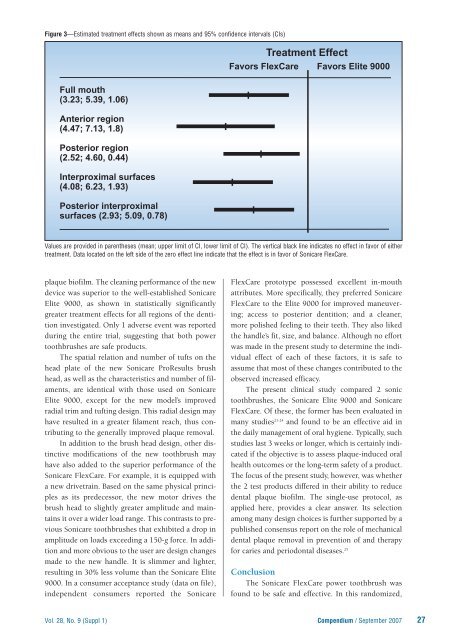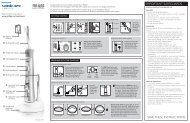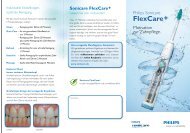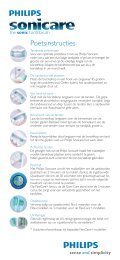Philips Sonicare FlexCare - Sonicare.com - Sonicare
Philips Sonicare FlexCare - Sonicare.com - Sonicare
Philips Sonicare FlexCare - Sonicare.com - Sonicare
Create successful ePaper yourself
Turn your PDF publications into a flip-book with our unique Google optimized e-Paper software.
Figure 3—Estimated treatment effects shown as means and 95% confidence intervals (CIs)<br />
Treatment Effect<br />
Favors <strong>FlexCare</strong> Favors Elite 9000<br />
Full mouth<br />
(3.23; 5.39, 1.06)<br />
Anterior region<br />
(4.47; 7.13, 1.8)<br />
Posterior region<br />
(2.52; 4.60, 0.44)<br />
Interproximal surfaces<br />
(4.08; 6.23, 1.93)<br />
Posterior interproximal<br />
surfaces (2.93; 5.09, 0.78)<br />
Values are provided in parentheses (mean; upper limit of CI, lower limit of CI). The vertical black line indicates no effect in favor of either<br />
treatment. Data located on the left side of the zero effect line indicate that the effect is in favor of <strong>Sonicare</strong> <strong>FlexCare</strong>.<br />
plaque biofilm. The cleaning performance of the new<br />
device was superior to the well-established <strong>Sonicare</strong><br />
Elite 9000, as shown in statistically significantly<br />
greater treatment effects for all regions of the dentition<br />
investigated. Only 1 adverse event was reported<br />
during the entire trial, suggesting that both power<br />
toothbrushes are safe products.<br />
The spatial relation and number of tufts on the<br />
head plate of the new <strong>Sonicare</strong> ProResults brush<br />
head, as well as the characteristics and number of filaments,<br />
are identical with those used on <strong>Sonicare</strong><br />
Elite 9000, except for the new model’s improved<br />
radial trim and tufting design. This radial design may<br />
have resulted in a greater filament reach, thus contributing<br />
to the generally improved plaque removal.<br />
In addition to the brush head design, other distinctive<br />
modifications of the new toothbrush may<br />
have also added to the superior performance of the<br />
<strong>Sonicare</strong> <strong>FlexCare</strong>. For example, it is equipped with<br />
a new drivetrain. Based on the same physical principles<br />
as its predecessor, the new motor drives the<br />
brush head to slightly greater amplitude and maintains<br />
it over a wider load range. This contrasts to previous<br />
<strong>Sonicare</strong> toothbrushes that exhibited a drop in<br />
amplitude on loads exceeding a 150-g force. In addition<br />
and more obvious to the user are design changes<br />
made to the new handle. It is slimmer and lighter,<br />
resulting in 30% less volume than the <strong>Sonicare</strong> Elite<br />
9000. In a consumer acceptance study (data on file),<br />
independent consumers reported the <strong>Sonicare</strong><br />
<strong>FlexCare</strong> prototype possessed excellent in-mouth<br />
attributes. More specifically, they preferred <strong>Sonicare</strong><br />
<strong>FlexCare</strong> to the Elite 9000 for improved maneuvering;<br />
access to posterior dentition; and a cleaner,<br />
more polished feeling to their teeth. They also liked<br />
the handle’s fit, size, and balance. Although no effort<br />
was made in the present study to determine the individual<br />
effect of each of these factors, it is safe to<br />
assume that most of these changes contributed to the<br />
observed increased efficacy.<br />
The present clinical study <strong>com</strong>pared 2 sonic<br />
toothbrushes, the <strong>Sonicare</strong> Elite 9000 and <strong>Sonicare</strong><br />
<strong>FlexCare</strong>. Of these, the former has been evaluated in<br />
many studies 21-24 and found to be an effective aid in<br />
the daily management of oral hygiene. Typically, such<br />
studies last 3 weeks or longer, which is certainly indicated<br />
if the objective is to assess plaque-induced oral<br />
health out<strong>com</strong>es or the long-term safety of a product.<br />
The focus of the present study, however, was whether<br />
the 2 test products differed in their ability to reduce<br />
dental plaque biofilm. The single-use protocol, as<br />
applied here, provides a clear answer. Its selection<br />
among many design choices is further supported by a<br />
published consensus report on the role of mechanical<br />
dental plaque removal in prevention of and therapy<br />
for caries and periodontal diseases. 25<br />
Conclusion<br />
The <strong>Sonicare</strong> <strong>FlexCare</strong> power toothbrush was<br />
found to be safe and effective. In this randomized,<br />
Vol. 28, No. 9 (Suppl 1) Compendium / September 2007<br />
27










